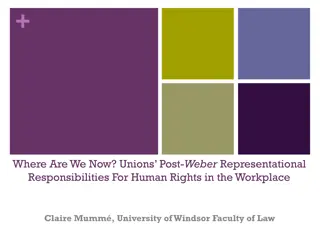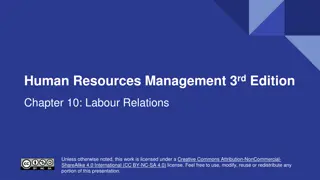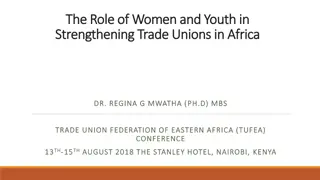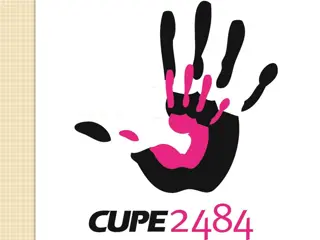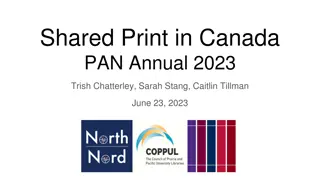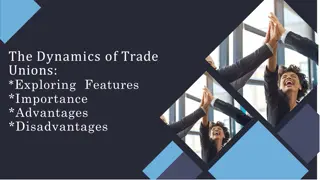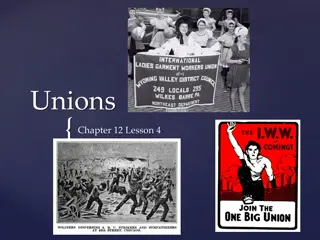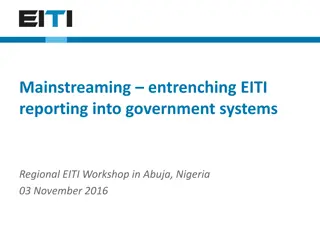Enhancing Financial Transparency in Canadian Unions
Explore the importance of financial transparency in Canadian unions through examples and regulations. Learn how rules vary, and why providing financial statements to members ensures accountability and trust within these organizations.
Uploaded on Sep 09, 2024 | 1 Views
Download Presentation

Please find below an Image/Link to download the presentation.
The content on the website is provided AS IS for your information and personal use only. It may not be sold, licensed, or shared on other websites without obtaining consent from the author. Download presentation by click this link. If you encounter any issues during the download, it is possible that the publisher has removed the file from their server.
E N D
Presentation Transcript
Union Accountability and the Law: Recasting the Current Debate Sean Tucker sean.tucker@uregina.ca Faculty of Business Administration University of Regina Wednesday, May 23, 2012
Wither Privacy? Publishing improves transparency, and this transparency creates a better society for all people. Better scrutiny leads to reduced corruption and stronger democracies in all society s institutions, including government, corporations and other organisations. Wiki leaks, 2012. 2
Transparency Demanded Across Domains Most (83%) Canadians agree that food and beverage manufacturers need to be more transparent in the nutritional content of their products. Ipsos Ried poll, 2009 Almost 6 in 10 Canadians (58%) want more information about the work charities do in order to make good choices about where to donate. Canadian Centre for Philanthropy, 2000. 87% of respondents totally agree that (US) Federal government officials should provide information on financial management that is transparent to citizens. Harris Interactive, 2009. 3
Transparency, Accountability, and Trust Trust Accountability Transparency 4
Financial Transparency among Canadian Unions Generally, rules vary by union constitution and jurisdiction. Example 1: 6.4 The Secretary-Treasurer shall: b) present an account of the Association's finances to each annual general meeting; c) maintain books of account and make these available to the members of the Association on request; Source: University of Regina Faculty Association, Constitution. 5
Financial Transparency among Canadian Unions Example 2: Section 132.1(1) At the request of a member, every union shall give the member, at no charge, a copy of a financial statement of the union's affairs to the end of its last fiscal year. The statement must be certified to be a true copy by the union's treasurer or other officer responsible for handling and administering its funds. (2) A union's financial statement must set out its income and expenditures for the fiscal year in sufficient detail to disclose accurately the union's financial condition and operation and the nature of its income and expenditures. Source: Manitoba Labour Relations Act 6
Private Members Bill C-377: An Act to amend the Income Tax Act (requirements for labour organizations) Russ Hiebert introduces his private member s bill in the House of Commons http://www.youtube.com/watch?v=lrGQ7ylBFuM View 0:00 to 2:45 7
Private Members Bill C-377 Balance sheet, income statement Identify all transactions over $5,000 with name of payer & payee, address, and description of transaction Statements of loans, assets, and investments 8
Private Members Bill C-377 Salaries of officers and directors. Percentage of time dedicated to political and lobbying activities Salaries of employees and contractors. Percentage of time dedicated to political and lobbying activities 9
Private Members Bill C-377 Labour relations, political, lobbying, gifts, grants, administration, overhead, organizing, bargaining, conference, convention, education, and training. 10
Private Members Bill C-377 Legal and any other prescribed statements 11
Mandatory Public Disclosure of Union Financial Information in the U.S. Annual reports can be accessed at this link: http://www.dol.gov/olms/regs/compliance/rrlo/lmrda.htm#1 For example: AMERICAN FEDERATION OF SCHOOL ADMINISTRATORS LOCAL 1 12
Private Members Bill C-377 Public disclosure will help the public better understand how the benefits that are provided are being utilized. This is in line with the increased transparency we have introduced for government departments, agencies and native reserves. It is also in line with the public disclosure required of charities and political parties, which also receive substantial public benefits through the tax system. I want to note that public disclosure is strongly supported by the Canadian public and by union workers themselves. Source: Hansard, Russ Hiebert, December 5, 2011. 13
1. Canadians Demand Public Disclosure With the passage of the bill, the public would be empowered to gauge the effectiveness, financial integrity and health of any labour union. This is something that Canadians want. According to a Nanos poll taken on Labour Day of last year, 83% of Canadians and 86% of union members want public financial disclosure for unions. Source: Hansard, Russ Hiebert, February 6, 2012. 14
1. Canadians Demand Public Disclosure www.c377.ca/en Your bill is particularly timely, in fact, given that a recent Nanos Research poll found that 83 per cent of working Canadians believe that the law should require both public and private sector unions to be financially transparent with the public. Source: Canadian Federation of Independent Businesses. October 19, 2011. 15
1. Canadians Demand Public Disclosure Source: A Consultation Paper on the Renewal of Labour Legislation in Saskatchewan (May 2, 2012), p. 13. 16
Labour Watch-Nanos Public Opinion Poll (2011) 83% of Canadians agreed with mandatory public financial disclosure for both public and private sector unions on a regular basis. Source: State of the Unions 2011 - LabourWatch August 2011 17
Labour Watch-Nanos Public Opinion Poll (2011) Two problems with this poll: Priming effect and social desirability Suppressing results 18
Priming 19
Priming and Social Desirability In fact, respondents were also provided with the following information: As you may know, public and private sector unions do not pay taxes, the union dues of unionized employees of the private and public sectors are tax deductible and their strike pay is not taxable. In addition, tax payers pay the wages of civil servants and, therefore, fund their union dues. Please tell me whether you COMPLETELY AGREE, SOMEWHAT AGREE, SOMEWHAT DISAGREE OR COMPLETELY DISAGREE with the following statement: It should be mandatory for unions from both the private and public sectors to publicly disclose detailed financial information on a regular basis. Source: Source: State of the Unions 2011 - LabourWatch August 2011 (updated version, date not known), p. 36. Available at: http://www.nanosresearch.com/library/polls/2011StateoftheUnions.pdf 20
Priming and Social Desirability The information prefacing the statement on the previous slide did not appear in the original Labour Watch-Nanos report that was released on September 5, 2011. 21
Suppressing Results On page 3 of the original report, it is stated that: Canadians were divided on whether the Canadian public or just union Members/unionized employees should have access to unions financial information. Wait just one minute! Didn t 83% of respondents support public disclosure? What is the basis for the claim about divided opinion? 22
Suppressing Results In fact, respondents were provided with the following information and question: In the United States, detailed disclosure of specific financial information is required by all unions to be made available to anyone who wants it. In Canada, some provinces do not have any requirements for unions to disclose financial information, while others require limited financial information be provided to union members only upon request. Continued on the next slide... Source: Source: State of the Unions 2011 - LabourWatch August 2011 (updated version, October 29, 2011), p. 30. Available at: http://www.nanosresearch.com/library/polls/2011StateoftheUnions.pdf 23
Suppressing Results In your opinion, who should have access to the financial information of unions operating in Canada? Unionized employees ................................... 1 Actual union members only ......................... 2 The Canadian public (i.e. everyone) ............. 3 No one .......................................................... 4 The information on the previous slide, the above question and related results did not appear in the original Labour Watch-Nanos report. 24
Suppressing Results In late-October, Nik Nanos added an appendix to the original report that explains why the responses to the previous question were suppressed. The following reasons were provided: - Response categories were not mutually exclusive (e.g., no all of the above choice) - Vagueness of the term access 25
Are Canadians Demanding Public Disclosure? How reliable are the Labour Watch-Nanos results given the probable effects of priming and social desirability, and the difficulty associated with reconciling the results below? 83% support public disclosure of union financial information Opinion was divided over whether the public or just union members should have access to union financial information 26
2. Substantial Public Benefit The federal government forgoes $795 million in tax revenue each year for union and professional dues. The majority of this amount is claimed by union members, probably in the range of $400 million to $500 million. This is a substantial public benefit. Source: Hansard, Russ Hiebert, February 6, 2012. 27
2. Substantial Public Benefit If there is an ideology, it is based on the principle that organizations that receive public benefits should be accountable to disclose how they use those benefits. (emphasis added) Source: Hansard, Russ Hiebert, February 6, 2012. 28
2. Substantial Public Benefit Why does the principle only apply to charities and unions? Should the principle extend to... ... professional dues? ... government subsidies received by organizations? ... various tax credits and other tax deductions claimed by organizations? 29
Key Questions 1. Should organizations that receive a direct or indirect benefit through the tax system be required to publicly disclose their financial information? 30
Key Questions 2. Assuming the answer to the first question is YES: Under what circumstances would an organization that receives a direct or indirect benefit through the tax system be exempt from publicly disclosing their financial information? 31
Key Questions 3. Again, if the answer is YES to the first question: (a) What financial (and non-financial) information should be publically disclosed? (b) Should the scope of disclosure be proportional to the size of the benefit received (i.e., the greater the public benefit the more detailed the disclosure)? 32
Implications for Saskatchewan May 2, 2012 Consultation paper. Possible legal challenge of C-377 (jurisdiction) Prospects for a debate about the principle of requiring organizations that receive benefits through the tax system to publicly disclosure financial information? 33
Further Reading Lund, J. (2009). Financial reporting and disclosure requirements for trade unions: a comparison of UK and US public policy. Industrial Relations Journal, 40, 2, 122-139. Lund, J. and J. McLuckie (2007), Labor Organization Financial Transparency and Accountability: A Comparative Analysis , Labor Law Journal, 58, 4, 251 266. Lund, J. and B. J. Roovers (2008), Through the Looking Glass: Does the Labor Department s New Form LM-2 Really Deliver Greater Transparency? , Labor Studies Journal, 33, 3, 309 329. 34



